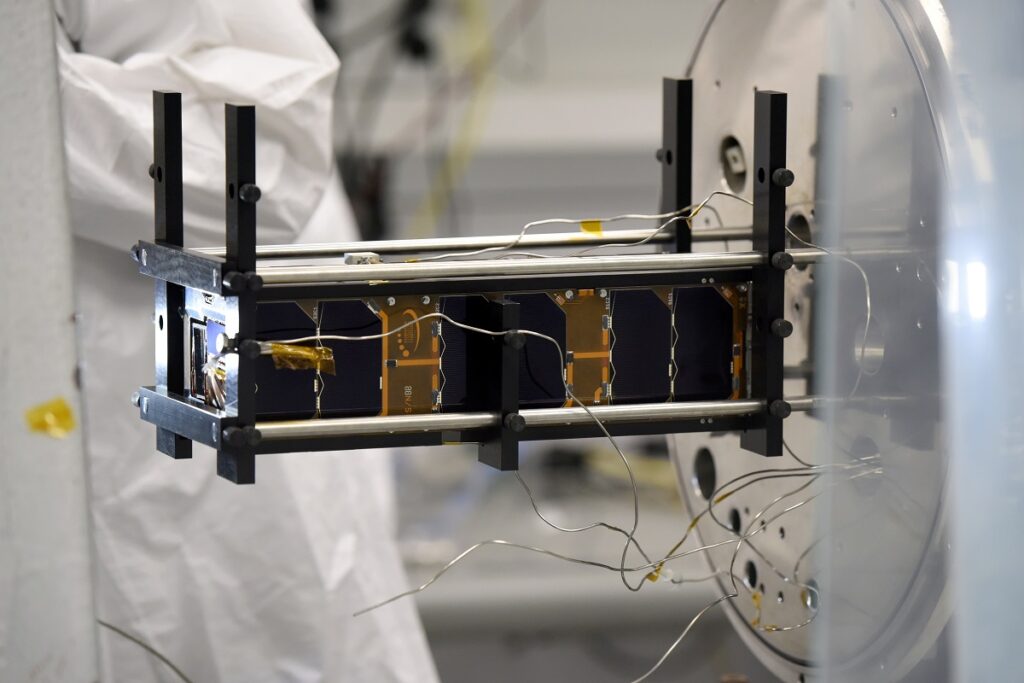Tel Aviv University (TAU) is set to launch its own satellite into space early next year to conduct a series of experiments while in orbit, the first such project undertaken by an Israeli academic institution.
The satellite, dubbed the TAU-SAT1, is a nanosatellite developed, assembled, and tested at the new Nanosatellite Center at TAU, an interdisciplinary endeavor of the Faculties of Engineering and Exact Sciences and the Porter School of the Environment and Earth Sciences. It has been in development for two years.
The satellite is currently undergoing pre-flight testing at the Japanese space agency JAXA, after which it will be sent to the United States to hitch a ride in early 2021 on a NASA and Northrop Grumman resupply spacecraft destined for the International Space Station, the university said in a statement.
Once at the station, the TAU-SAT1 will be released into a low-earth orbit approximately 400 km above the Earth. At this altitude, the nanosatellite will orbit our planet at a speed of 27,600 km per hour, or 7.6 km per second, completing an orbit every 90 minutes, the university said.

Ofer Amrani, head of Tel Aviv University’s miniature satellite lab, said the TAU-SAT1 is a nanosatellite of the CubeSat variety, a type of miniaturized satellite for space research that is made up of multiples of 10 cm × 10 cm × 10 cm cubic units with a mass of some 1.33 kg per unit.
The TAU-SAT1’s “dimensions are 10 x 10 x 30 cm, the size of a shoebox, and it weighs less than 2.5 kg,” Amrani said.
According to the university, the satellite will conduct a number of research experiments, including measuring cosmic radiation in space.
“We know that that there are high-energy particles moving through space that originate from cosmic radiation,” said Meir Ariel, director of the university’s Nanosatellite Center, in a university statement. “Our scientific task is to monitor this radiation and to measure the flux of these particles and their products. It should be understood that space is a hostile environment, not only for humans but also for electronic systems. When these particles hit astronauts or electronic equipment in space, they can cause significant damage. The scientific information collected by our satellite will make it possible to design means of protection for astronauts and space systems.”
The experiments were developed by the Space Environment Department at the Soreq Nuclear Research Center.
To collect the data, the university built a satellite station on the roof of the engineering building. The station also serves as an amateur radio station, and has an automated control system.
“When TAU-SAT1 passes ‘over’ the State of Israel, that is, within a few thousand-kilometer radius from the ground station’s receiving range, the antennas will track the satellite’s orbit and a process of data transmission will occur between the satellite and the station,” said Amrani.

Transmissions are expected to take place about four times a day, with each one lasting less than ten minutes, Amrani explained. In addition to its scientific mission, the satellite will also serve as a relay station for amateur radio communities around the world, according to TAU.
The satellite is expected to be active for several months in total. “Because it has no engine, its trajectory will fade over time as the result of atmospheric drag—it will burn up in the atmosphere and come back to us as stardust,” said Amrani.
New space revolution
Launching the TAU-SAT1 nanosatellite is the university’s first step on its path toward joining the “new space” revolution that is opening up the industry to civilian players.
Since the satellite was developed and tested with a team of students and researchers and the infrastructure was built entirely in-house—from the cleanrooms to the testing facilities to the receiving and transmission station—the university expects to begin development on TAU-SAT2, and said it opens the door for more research.
“The idea is that any researcher and any student, from any faculty at Tel Aviv University, or outside of it, will be able to plan and launch experiments into space in the future—even without being an expert in the field,” the university said.
“We are seeing a revolution in the field of civilian space,” explained Colin Price, one of the academic heads of the new center.
“We call this new space as opposed to the old space, where only giant companies with huge budgets and large teams of engineers could build satellites. As a result of miniaturization and modulation of many technologies, today universities are building small satellites that can be developed and launched in less than two years, and at a fraction of the budget in the old space,” Price added.
This article first appeared in NoCamels, which covers innovations from Israel for a global audience.

